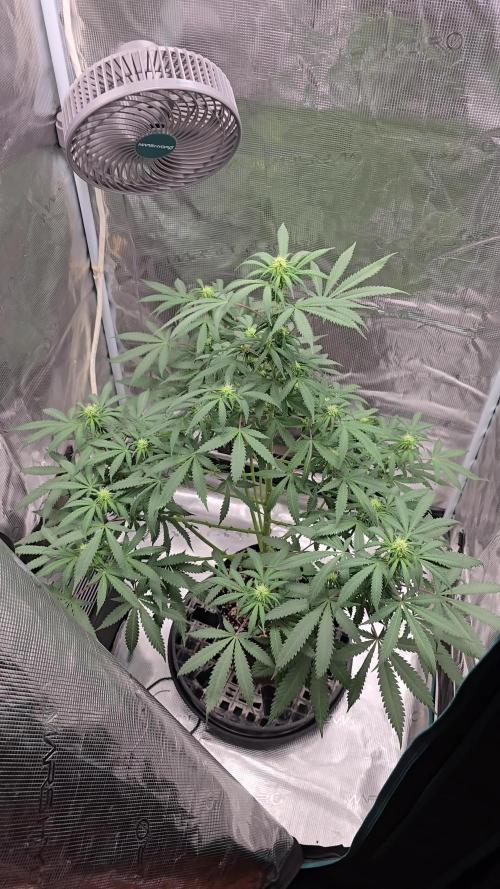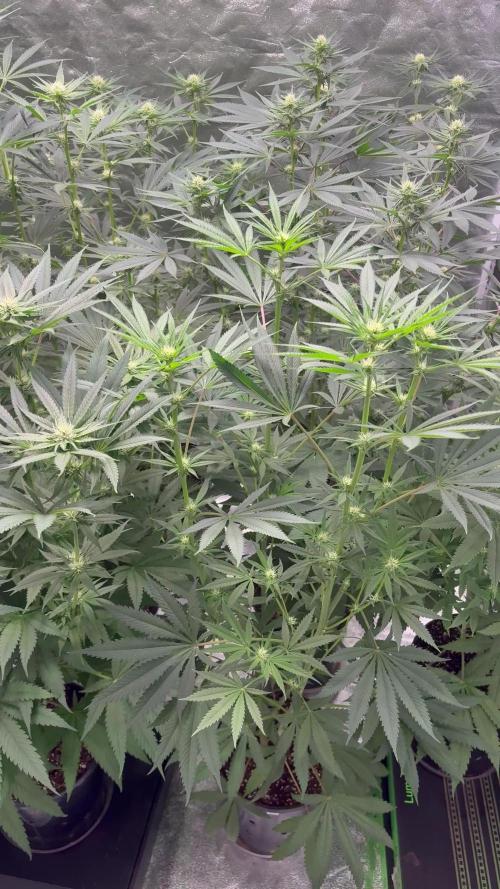The Grow Awards 2026 🏆 

































Likes
Comments
Share


@Snoopy
Follow
7-600w led viperspectra
2-3500btu a/c units
1-6inch intake
1-6inch exhaust/carbon filter
1-4inch intake
1-4inch exhaust/carbon filter
21- mix bag plants / alien,granddaddy purple,hashplant,og kush
1-General hydroponics feed 2ml veg and bloom
1-first time grower
Likes
12
Share


@603grower
Follow
She came out amazing. Super frosty. I got exactly 2 ounce off of her I wish I vegged her out a few more weeks and got a few more branches. Every still branch was stacked! I love useing this site really helps me keep track of my grow and what I’ve done!
Likes
9
Share


@Headies
Follow
So this week after I gave it under nutrients I apparently gave it too much nitrogen while having a potassium deficiency. Shiney dark leaves, So i fixed that, but some didn't bounce back, and I tried nitrogen. I think they are doing pretty good considering everything I've put them through SO FAR. lol. Nutrients are NPK Raw's total lineup, follow their instructions at first, Fastbuds adjustments as of this week.
Processing
Likes
10
Share


@DudeGrowsWeed
Follow
WOW!!! She's f'ing huge!!! Definitely the largest auto I've ever grown. The bud sites are still in early development but she's beautiful. However, I think she's suffering a little from the heat in the attic (where my grow tent is). I'll be moving her outside in the next week or so in an effort to help her out. Hoping for the best! 🙏
Likes
12
Share


@Naujas
Follow
Well, that day has come, the girl would have been really different if not for the high temperature, strong light, and a huge lack of potassium :( well, everything will be fine next time :) live and learn :) I am satisfied with the result, which is what I need :) got 200 gr of liquid :) gathered a lot of sugar leaf :) they are already in the sweet shop :D I will make an addition!! good growth and success :)
Likes
17
Share


@420DeepGrow
Follow
Gracias al equipo de AnesiaSeeds, Marshydro, XpertNutrients y Trolmaster sin ellos esto no sería posible.
💐🍁 Sticky Boof:
Prepárate para dejarte llevar por Sticky Boof, nuestra última obra maestra que está poniendo el listón muy alto para los amantes de las índicas. Nacida del legendario cruce de Super Boof y Cadillac Rainbow, Sticky Boof es una potente planta con un asombroso 80% de dominancia Indica que promete una relajación sin igual.
Prepárate para un viaje épico con el asombroso 37,5% de THC de Sticky Boof.
Sumérgete en una cosecha abundante con Sticky Boof, que produce hasta la friolera de 500 g/m² en interior y 800 - 900 g por planta en exterior. Esta variedad es generosa y está lista para llenar tu alijo de cogollos de la mejor calidad.
Sticky Boof es todo rapidez y eficacia, acelerando el tiempo de floración en sólo 7 u 8 semanas.
💡TS-3000 + TS-1000: se usaran dos de las lámparas de la serie TS de Marshydro, para cubrir todas las necesidades de las plantas durante el ciclo de cultivo, uso las dos lámparas en floracion para llegar a toda la carpa de 1.50 x 1.50 x 1.80.
https://marshydro.eu/products/mars-hydro-ts-3000-led-grow-light/
🏠 : Marshydro 1.50 x 1.50 x 1.80, carpa 100% estanca con ventanas laterales para llegar a todos los lugares durante el grow
https://marshydro.eu/products/diy-150x150x200cm-grow-tent-kit
🌬️💨 Marshydro 6inch + filtro carbon para evitar olores indeseables.
https://marshydro.eu/products/ifresh-smart-6inch-filter-kits/
🍣🍦🌴 Xpert Nutrients es una empresa especializada en la producción y comercialización de fertilizantes líquidos y tierras, que garantizan excelentes cosechas y un crecimiento activo para sus plantas durante todas las fases de cultivo.
Consigue aqui tus Nutrientes:
https://xpertnutrients.com/es/shop/
💻 Trolmaster Tent-X TCS-1 como controlador de luz, optimiza tu cultivo con la última tecnología del mercado, desde donde puedes controlar todos los parametros.
https://www.trolmaster.com/Products/Details/TCS-1
🍣🍦🌴 Xpert Nutrients es una empresa especializada en la producción y comercialización de fertilizantes líquidos y tierras, que garantizan excelentes cosechas y un crecimiento activo para sus plantas durante todas las fases de cultivo.
Consigue aqui tus Nutrientes:
https://xpertnutrients.com/es/shop/
📆 Semana 4:
Los cogollos se siguen formando poco a poco y ellas comienzan a llenarse de resina.
Creo que al haberla puesto tan pronto y debido a la luz solar ha entrado en floración antes de lo previsto.
Continúo con las dosis de nutrientes recomenda por el fabricante.
Likes
14
Share


@JustChillTHC
Follow
Week 3 - Pre-Flower
Good a little nuteburn I quess, this week only pH'd Water.
I think the Nuteburn is because I used Root Juice for a longer time then advertised, so yeah.
Likes
31
Share


@Hempface86
Follow
So like I said last week, this is definitely not an autoflower..10 weeks of veg in a one gallon container, it makes absolute, you know sense, and the second I flipped her, she flipped... So at this point i'm just hoping it's still purple haze... i will say she's been happy and she's growing right along, as you can tell she's crowning nicely, and she's stacking fairly quickly for what's supposed to be a heavier sativa leaning plant ... by the looks of her plant leaves, she looks like a right down the middle of the road hybrid.. As long as when she's all said and done, she looks and smokes good.You won't hear me complain... I really hope everyone is doing well. God bless and a happy growing ✌️
Likes
36
Share


@SAC87
Follow
Update: Took less than 3 days for all 3 seeds to pop. They’re all looking good, standing tall. Couple shells stuck to cotyledon leaves. I’m just going to leave them there. In the past my OCD has wanted them off and I’ve F’d up the leaf. I’m going to leave them covered with the cups until tomorrow, hopefully true leaves will be starting then.
I got an email from FastBuds and it showed their suggested feed schedule so I’ll try that and see how they like it.
Hi Growers. The sponsored FastBuds Auto seeds have arrived!!!! I decided to run the Pineapple Express and the Blue Dream. According to the grow info on the website they seemed to be in the same size and duration range. It should also give me a wider variety of effect as well.
I planted 3 seeds of each strain directly in 3 gal fabric pots of new Sunshine #4 mix and lightly watered with RO water. They’ll be lit by a Spider Farmer SF4000 which is on 24 hrs at the moment at 30% around 30 inches high.
I have enjoyed the FastBuds seeds I’ve grown before and was very happy to receive this sponsorship. It was very kind. Thank you.
I have always wanted to grow the Pineapple Express and am glad to have this opportunity. 👍🏻👍🏻
Anything with Blueberry genetics has always been good for my GI disorder and Blue Dream specifically has always worked well for that. My wife finds it’s great for her PTSD and anxiety too. I’ll be happy to have a bunch of bud from these two around fairly soon.
Happy Growing 🌱
Likes
7
Share


@MrGrowthSpurt
Follow
Easy strain to grow, it is true to it's name and grows some big buds. You will need to tie them up or use a trellis to keep them from dropping.
Overall I am satisfied with my results with over 2 ounces per plant.
Likes
176
Share


@NuggetPawn
Follow
So, with the harvest complete and the dry finished, the rest is now going into jars for the final cure and storage.
Overall I enjoyed this grow, it needed minimal interventions and had a smaller work load compared to the other grows.
The amount of dried flowers is 752g (1.11gpw) so a decent haul, I threw a lot of B grade buds in the hash bag due to the large number of low level flowering sites (I need to rethink my canopy management) and also with the lack of stretch after flipping made the internodal spacing a bit too tight. Managed to extract 215g of grade a hash from her as well which I have pressed into a slab (pictures).
I learned many things along the way, namely root health and the importance of keeping organic additions as low as possible. I also decided to try out clones for my next run, just to get a little more canopy and growth consistency - those of which are in an aeroponics tub at the moment waiting to root (picture).
Thanks for those of you who followed along most of the way, good luck with all your grows!
Likes
8
Share


@FireAntTheGrower
Follow
Gary Payton smell earthy pine on the nose. Very smooth on the exhale . Smoking a blunt and feeling good outside today 6/20/24. On my way to get tattoo so yeah I need to be high as a kite right now . Good looking MSNL I’m a return buyer.
Likes
24
Share


@3lementa1
Follow
Fed nutes at 6.3 pH. Runoff was close to 7 pH. Other than that they look like they're doing well. Very sticky and very fragrant.
The leaves of the CBD Blue Shark are a nice dark shiny green. The Wedding Cake is lighter. The profiles of both are starting to come out in the flowers. The CBD Blue Shark has these long, dramatic white pistils. The Wedding Cake is starting to show its creamy colouration with red hairs mixing in with the white and looking very delicious.
The smell is incredible in there now. Fruity and creamy and delicious.
Likes
44
Share


@SooSan
Follow
12/12 + 35 jours
Vu qu’il y a 16 plantes mais que sur growdiaries on ne peut mettre que 8 variétés j'ai divisé en 2 diaries pour le bas de la tente
1️⃣
🏠 90x60x90
☀️ FC-E 4800 => puissance a 20%
🍁
1x Black Bomb / Philosopher Seed
2x Amnesia Lemon / PEV Seeds
1x Blueberry / PEV Seeds
1x Blueberry / 00 Seeds
1x Wappa / Paradise Seed
1x Dark Phoenix / Green House Seed
1x Quick Sherbet / Exotic Seeds
1x Mango Cream / Exotic Seeds
1x Banana Frosting / Sensi Seed
1x Hindu Kush / Sensi Seed
3x Fast Mix / Sweet Seed
📎 https://growdiaries.com/diaries/122084-grow-journal-by-soosan
📎https://growdiaries.com/diaries/124052-grow-journal-by-soosan
2️⃣
🏠 30x60x50
☀️TS1000 => puissance a 50%
🍁 4x Quick Sherbet - Exotic Seed
📎 https://growdiaries.com/diaries/122080-grow-journal-by-soosan
Likes
1
Share


@Ninjabuds
Follow
Week three of flower is off to an amazing start! At day 22, the ladies are looking incredibly healthy. They're praying like crazy, reaching for the light, and stacking nodes like it's their job. The buds are starting to plump up, and the trichome production is getting intense. I'm so excited to see how they develop over the next few weeks!
Processing
Likes
10
Share


@HisHope
Follow
12/28 Week 9
Maddie is on a water only diet not making her cranky yet
Tammy is still stuffing her face at the buffet table happy as she can be
12/29
Picture day!
Likes
5
Share


@Mr_nugs_lover_David
Follow
I have had a very nice journey growing her, she has given a great quality and quantity pf buds, very hard dense flowrs with a clasic strong amnesia smell that I enjoy a lot specially for the happy energetic buzz that provides you.






















